Chemical Car
-
- MARICHEM 80 Maritime Reporter, Oct 1980 #28
Third International Conference On Marine Transportation, Handling And Storage of Bulk Chemicals This year's International Conference on the Marine Transportation, Handling and Storage of Bulk Chemicals—MariChem 80— will be held October 21-23 in the Royal Lancaster Hotel in London, England. The leading role of London in the international shipping industry, and as the headquarters of the Inter-Governmental Maritime Consultative Organization (IMCO), the maritime arm of the United Nations that formulates many of the regulations governing the transportation of bulk chemicals, adds particular significance to the choice of the British capital as the host city.
MariChem 80 will look at problems and hazards of bulk chemicals transportation, and the increasing use of multimodal tank containers for potentially dangerous liquids will be discussed by a panel of experts in the field.
MariChem will be a working meeting for all concerned with the safe and efficient carriage of bulk chemicals; the safety aspect dominates in all sections of the conference program. Speakers have been drawn from government agencies, vessel operators, shipping and tank container experts, research organizations, and other areas. The program lists speakers from the United States, the United Kingdom, France, West Germany, Norway, and Sweden.
Growing Cost Of Safety Legislation and regulations continue to dominate the day-to-day business of chemical shipping, and there is considerable concern in the industry on the ever-growing cost of meeting national and international requirements for safe operation. Many owners argue that purely commercial pressures already insure the safe and pollution- free carriage of bulk chemicals.
This point of view has been argued strongly at previous Mari- Chem conferences, and the London meeting will see John Spruyt of Gotaas-Larsen, and Tim Berkel, president of the increasingly influential U.S. Chemical Carriers Association, putting forth the operators' points of view in vigorous fashion.
Explanations and expositions from the U.K. Department of Trade and Department of Industry and from the U.S. Coast Guard will attempt to provide some of the reasoning behind the most important items of legislation and regulation. A keynote paper in this session will be presented by Neil Hurford of the Department of Industry's Warren Spring Laboratory. The subject of his paper is a review of the IMCO standards for procedures and arrangements for the discharge of noxious liquid substances.
The IMCO standards are currently the cause of considerable discussion in the industry, as implementation in full is bound to involve operators in the expenditure of a good deal of extra time, effort, and money. Delegates to the MariChem 80 meeting therefore will be eager to hear a paper by Eckhart Slovke from Dow Chemical's Maritime Technical Centre. He will describe a novel approach to stripping and tank washing of chemical parcel tankers "that holds promise of reducing the cost of chemical transport by sea even before MARPOL 73 has been ratified." Explosion Hazards The second day of the conference will, like the two earlier meetings in the MariChem series, be devoted largely to operations and safety matters. Explosion hazards and relevant safety measures at vapor recovery plants will be discussed by Dr. K. Schampfel of the Physikalisch-Technische Bundesanstalt, Brunswick, West Germany. In view of the increasing regulatory and economic requirements for efficient vapor recovery systems, his paper is a timely indication of the industry's concern for their safety.
D.J. Bryce, the U.K. health and safety executive who recently imposed stricter security measures at the liquefied natural gas terminals at Canvey Island, will present a paper on safety considerations at shipping terminals for hazardous bulk materials.
T.K. Jenssen of the Norwegian classification society Det norske Veritas will describe his work on public risk analysis applied to the transport of hazardous cargoes, and a leading specialist from the Netherlands, A.A. Damsteeg, will report on a study conducted for the Rotterdam authorities on emergency planning in ports. British, Norwegian, and Dutch speakers will describe their approaches to the training of chemical car- rier personnel; despite various d i f f e r e n c e s in approach, each speaker will begin with the premise that "safety starts with a well-trained crew." A detailed survey of chemical carrier " i n c i d e n t s " leads Don Butcher of Northeast London Polytechnic to ask, "How safe are chemical tankers?" Mr. Butcher is a well-known contributor in the chemical transportation / safety field, and the results of his survey are bound to be of considerable interest.
MARICHEM CONFERENCE PROGRAM Tuesday, October 21 Session 1—Legislation and Regulation Chairman: U. Ackerman, Reederei de Vries & Co., Hamburg.
2:30 p.m.—A Review of the IMCO Standards for Procedures and Arrangements for the Discharge of Noxious Liquid Substances: N. Hurford, Department of Industry, Warren Spring Laboratory, Stevenage, Herts.
3:00 p.m. — Effective Regulation in Chemical Shipping: C.J. Spruyt, Gotaas- Larsen, London.
4:00 p.m.—Regulations—The Growing Management Burden: T.G. Berkel, Stolt Nielsen Inc., president, Chemical Carriers Association, New York.
4:30 p.m. — Overflow Control — Proposals for a Linked Ship-Shore System: R.C. Gray, British Shipbuilders, Newcastle- upon-Tyne.
5:00 p.m.—Chairman's Remarks WEDNESDAY, OCTOBER 22 Session 2—Operation and Safety Chairman: Capt. A. Allievi, Shipping Safety Coordinator, Esso Europe Inc., London.
9:00 a.m. — Explosion Hazards and Relevant Safety Measures at Vapor Recovery Plants: K. Schampel, Physikalisch- Technische Bundesanstalt, Braunschweig, West Germany.
9:30 a.m.—Safety Considerations Relevant to Shipping Terminals for Hazardous Bulk Material: D.J. Bryce, Health and Safety Executive, London.
10:00 a.m. — Emergency Planning in Ports: A.A. Damsteeg, Voorschoten, the Netherlands.
11:00 a.m. — Parcel Tanker Training for an Effective Endorsement: G. Mc- Guire, Hazardous Cargo Handling Unit, Leith Nautical College.
11:30 a.m. — Advances in Special Training in Norway for Personnel on Ships Carrying Liquid Chemicals in Bulk: J.E. Johnsen, Ship Research Institute of Norway, Oslo.
12:00 Noon—Chemical Tanker Training Courses in the Netherlands: A.J.
Barendregt, Chemical Laboratory, "Dr.
A. Verwey", Rotterdam.
2:30 p.m.—Risk Analysis Applied to the Transportation of Hazardous Cargoes— Some Examples Related to Public Risk: T.K. Jenssen, Det norske Veritas, Oslo.
3:00 p.m. — How Safe Are Chemical Tankers?: D. Butcher, N.E. London Polytechnic, London.
Session 3—Tank Containers in the Chemical Trades Chairman: Lt. K. Eldridge, U.S. Coast Guard, Washington, D.C.
4:00 p.m.—Reciprocal Acceptance of Tank Containers: B. Schulz-Forberg, Bundesanstalt fur Materialprufung, Berlin.
4:20 p.m. — Tank Containers in the Chemical Trades—the Views of a Tank Container Through Operator: J.A. Ross, Trafpak Ltd., Aylesbury, U.K.
4:40 p.m. — Tank Containers in Bell Lines' Total Control Intermodal Services: R.P. Boneham, Bell Lines Ltd., Kenilworth, U.K., Secretary, Association of Tank Container Operators.
5:00 p.m. — U.S. Regulation of the Transportation of Hazardous Materials in Intermodal Tank Containers: Lt. K. Eldridge, USCG (Chairman).
THURSDAY, OCTOBER 23 Session 4—Technical Developments Chairman: R.C. Gray, British Shipbuilders, Newcastle-upon-Tyne.
10:30 a.m. — A Cost-Benefit Analysis for Installation of Separate Deck-Mounted Cargo Tanks on Parcel/Chemical Carriers: A. Wiborg, Shipping Consultants A/S, Oslo.
11:00 a.m.—Slops and Residue Disposal— A New Approach: E.A. Stoyke, Dow Chemical GmbH, Stade/Stadersand, Germany.
11:30 a.m.—Developments in Cargo Pumping Arrangements: M. Mohn Westlake, Frank Mohn UK Ltd., and M. Sigmundstad, Frank Mohn AS, Nesttun, Norway.
12:00 Noon—Experience With Cargo Monitoring Systems: A. Eian, Autronica A/S, Trondheim, Norway.
2:00 p.m. — New Developments in Toxic Gas Detection Using a Silicon Semiconductor Sensor: Sema Electronics Ltd.
Tank Coatings and Linings— Panel Session 2:30 p.m.—Tank Coatings: A.V. Robinson, Camrex Ltd., Sunderland.
2:45 p.m.—Rubber Lining and Chemical Carriers, Storage Tanks and Pipelines: R. Heinrichs, Clouth Gummiwerke AG, Cologne.
3:00 p.m. — Criteria for Selection of Either Steel Plates or Coatings for Ships Transporting Phosphoric Acid: J. Pauthier, Technigaz, Maurepas, France.
3:15 p.m.—A Survey of Some Failures Typical for Tanks and Piping Systems in Austentic Stainless Steel; Preventive Measures: S. Evant and A. Berg, Det norske Veritas, Oslo.
3:30 p.m. — Corrosion Resistance of Stainless Steels to Chlorinated Hydrocarbons: S. Nordin, Nyby Uddeholm AB, Uddeholm.
5:00 p.m.—Chairman's remarks Panel On Tank Containers Part of the conference program will debate a subject of growing importance, and one that has probably caused more concern for safety than any other aspect of bulk chemicals carriage: the question of multimodal tank containers in the chemical trades. While the legislators appear to have covered adequately the various categories of ship/cargo combinations in the chemical parcel trades, it remains a fact that large quantities of bulk chemicals are being shipped around the world in tank containers aboard normal RO/RO and cellular containerships.
The tragic results from a leaking container, safely stowed in a cellular containership hold, occupied the media a few years ago.
A good deal of work has been done since then to attempt to prevent a recurrence of this kind of accident, but there is much to be done and the whole question of hazardous chemicals in intermodal tank containers must be subjected to careful scrutiny.
A major company specializing in this trade reports that there is no legislation governing the qualifications of transport companies to carry hazardous materials and that the whole business is in danger of being led, under-regulated, towards a possible crisis.
Three major operators will be represented on the tank containers panel: Trafpak, by managing director John Ross; Bell Lines by Roy Boneham, who is also secretary of the newly formed Association of Tank Container Operators; and British Rail by Peter Mabbit. This panel also will include Bernd Schulz-Forberg from B.A.M., Berlin; Ch. Leclair of the French Department of Navigation ; and M. Querci of the French Ministry of Transport. Lt. Kevin Eldridge, USCG, U.S. representative on the IMCO Dangerous Goods Committee, will chair the panel session.
Technical Developments The final day of the MariChem 80 meeting will examine some of the technical developments that have, and continue to make possible, the bulk transportation of chemicals. Stainless steel linings and tanks are employed widely in bulk chemical transportation, although not universally suitable for all products, and a paper at the conference will report on their corrosion-resistance to chlorinated hydrocarbons.
Another paper, by two research engineers from Det norske Veritas, will discuss failures in stainless steel tanks and pipelines, and propose preventive measures.
A panel session at the final day's meeting, with representatives from manufacturers Clouth Gummiwerke, Camrex, and others, will discuss in-service results with typical chemical ship operators.
Speakers from the Frank Mohn Company, m a n u f a c t u r e r s of a w e l l - k n o w n range of chemical pumps, will put forward a paper on the contentious subject of cargo monitoring.
At previous MariChem conferences, some ship operators have complained that industry fails to provide the right equipment needed to monitor hazardous cargoes; MariChem 80 will give both sides the chance to air their views and to report on progress.
-
 )
March 2024 - Marine Technology Reporter page: 41
)
March 2024 - Marine Technology Reporter page: 41Image courtesy Outland Technology Image courtesy Exail Image courtesy Submaris and EvoLogics Vehicles The ROV-1500 from Outland Technology represents a leap forward in underwater robotics, a compact remotely operated vehicle (ROV) weighing in at less than 40 lbs (19kg) the ROV- 1500 is easy to transport
-
 )
March 2024 - Marine Technology Reporter page: 34
)
March 2024 - Marine Technology Reporter page: 34be recharged, known as cycle life. BATTERY BASICS FACTORS EFFECTING CAPACITY A cell generates electrical power through two galvanically Batteries work on chemical reactions. The chemical reaction active materials immersed in a conducting electrolyte. The rates are largely driven by temperature. The colder
-
 )
March 2024 - Marine Technology Reporter page: 23
)
March 2024 - Marine Technology Reporter page: 23underwater forests.” These for- ests are a hotspot of biodiversity and species richness. Underwater eruptions are also known to change the chemical nature of the ocean in the vicinity, creating localized disruptions to the oceanic food chain. DETECTING “Most volcanic activity in the world occurs
-
 )
April 2024 - Maritime Reporter and Engineering News page: 43
)
April 2024 - Maritime Reporter and Engineering News page: 43“The industry is an ecosystem which includes owners, managers, mariners, shipyards, equipment makers, designers, research institutes and class societies: all of them are crucial,” – Eero Lehtovaara, Head of Regulatory & Public Affairs, ABB Marine & Ports All images courtesy ABB Marine and Ports provi
-
 )
April 2024 - Maritime Reporter and Engineering News page: 13
)
April 2024 - Maritime Reporter and Engineering News page: 13. It is technically stupid, and quite long term carbon fuel use. frankly also economically unattractive from the driver’s point of If a liquid or other chemical fuel is needed, 7. view, since it simply increases their cost for getting from A to B. provide equipment that can use fuels that can As a
-
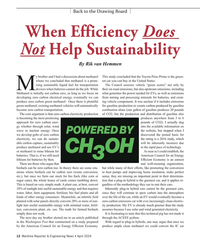 )
April 2024 - Maritime Reporter and Engineering News page: 12
)
April 2024 - Maritime Reporter and Engineering News page: 12Back to the Drawing Board When Efficiency Does Not Help Sustainability By Rik van Hemmen y brother and I had a discussion about methanol This study concluded that the Toyota Prius Prime is the green- where we concluded that methanol is a prom- est car you can buy in the United States. ising sustainable
-
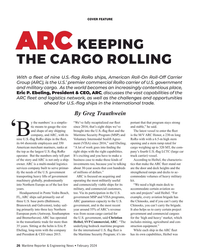 )
February 2024 - Maritime Reporter and Engineering News page: 26
)
February 2024 - Maritime Reporter and Engineering News page: 26COVER FEATURE ARC KEEPING THE CARGO ROLLING With a ? eet of nine U.S.-? ag RoRo ships, American Roll-On Roll-Off Carrier Group (ARC), is the U.S.’ premier commercial RoRo carrier of U.S. government and military cargo. As the world becomes an increasingly contentious place, Eric P. Ebeling, President
-
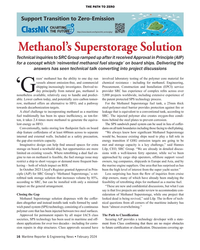 )
February 2024 - Maritime Reporter and Engineering News page: 16
)
February 2024 - Maritime Reporter and Engineering News page: 16methanol has the ability to one day run involved laboratory testing of the polymer core material for vessels almost emission-free, and commercial chemical resistance - including for methanol. Engineering, shipping increasingly investigates. Derived to- Procurement, Construction and Installation (EPCI)
-
 )
February 2024 - Maritime Reporter and Engineering News page: 11
)
February 2024 - Maritime Reporter and Engineering News page: 11down to a smaller size, and especially a smaller width relieves waterfront infrastructure footprints and costs. that issue. One may argue that one human with a bigger truck These 5-foot wide units will zip through the city much faster can deliver more cargo than one human with a smaller truck, and
-
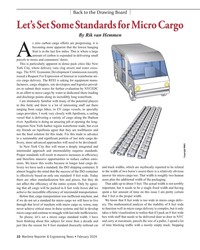 )
February 2024 - Maritime Reporter and Engineering News page: 10
)
February 2024 - Maritime Reporter and Engineering News page: 10Back to the Drawing Board Let’s Set Some Standards for Micro Cargo By Rik van Hemmen s zero carbon cargo efforts are progressing, it is becoming more apparent that the lowest hanging fruit is in the last few miles. This is where a large amount of carbon is expended in delivering small A parcels to
-
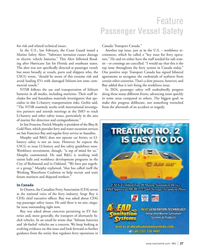 )
February 2024 - Marine News page: 27
)
February 2024 - Marine News page: 27Feature Passenger Vessel Safety ? re risk and related technical issues. Canada: Transport Canada.” In the U.S., last February, the Coast Guard issued a Another top issue, just as in the U.S. – workforce re- Marine Safety Alert: “Saltwater intrusion causes damage cruitment, which he called a “key issue for
-
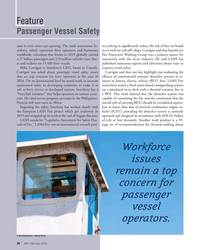 )
February 2024 - Marine News page: 26
)
February 2024 - Marine News page: 26Feature Passenger Vessel Safety ume is even more eye-opening. The trade association In- ect seeking to signi? cantly reduce the risk of ? res on board terferry, which represents ferry operators and businesses ro-ro (roll on–roll off) ships. Corrigan said that Interferry’s worldwide, calculates that
-
 )
January 2024 - Marine Technology Reporter page: 14
)
January 2024 - Marine Technology Reporter page: 14INSIGHTS SCIENCE RESEARCH MANAGEMENT © Who is Danny/AdobeStock PAVING THE WAY IN INTERNATIONAL SCIENCE RESEARCH MANAGEMENT Dr. Eleanor Darlington, Head of Marine Facilities Programs at the National Oceanography Centre (NOC), discusses how NOC is paving the way in international science research
-
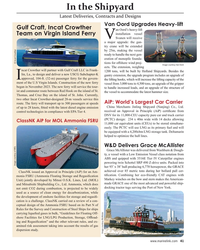 )
January 2024 - Maritime Reporter and Engineering News page: 41
)
January 2024 - Maritime Reporter and Engineering News page: 41In the Shipyard Latest Deliveries, Contracts and Designs Van Oord Upgrades Heavy-lift Gulf Craft, Incat Crowther an Oord’s heavy-lift installation vessel Team on Virgin Island Ferry VSvanen will receive a major upgrade: the gan- try crane will be extended by 25m, making the vessel ready to handle the
-
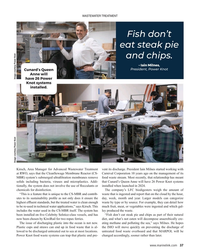 )
January 2024 - Maritime Reporter and Engineering News page: 37
)
January 2024 - Maritime Reporter and Engineering News page: 37Cunard’s Queen Anne will have 26 Power Knot systems tionally, the system does not involve the use of ? occulants or installed when launched in 2024. chemicals for disinfection. The company’s LFC biodigesters weigh the amount of “This is a feature that is unique to the CS-MBR and contrib- waste that is
-
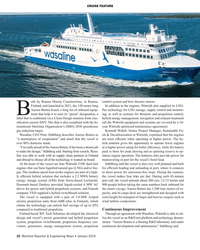 )
January 2024 - Maritime Reporter and Engineering News page: 32
)
January 2024 - Maritime Reporter and Engineering News page: 32CRUISE FEATURE uilt by Rauma Marine Constructions, in Rauma, control system and bow thruster motors. Finland, and launched in 2021, the 150-meter-long In addition to the engines, Wärtsilä also supplied its LNG- Aurora Botnia boasts a long list of onboard equip- Pac technology for LNG storage, supply
-
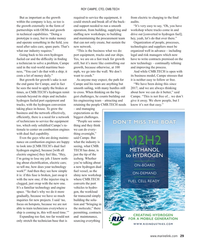 )
January 2024 - Maritime Reporter and Engineering News page: 29
)
January 2024 - Maritime Reporter and Engineering News page: 29ROY CAMPE, CTO, CMB.TECH But as important as the growth required to service the equipment, it from electric to charging to the fnal within the company is key, so too is could stretch and break all of the back- audits. the growth externally in the form of end support needed to run a smooth “It’s very
-
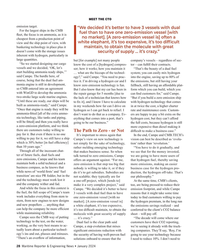 )
January 2024 - Maritime Reporter and Engineering News page: 28
)
January 2024 - Maritime Reporter and Engineering News page: 28MEET THE CTO emission target. “We decided it’s better to have 3 vessels with dual For the largest ships in the CMB fuel than to have one zero-emission vessel [with ? eet, the focus is on ammonia, as it is no market]. [A zero-emission vessel is] often a cheapest from a production point of white elephant
-
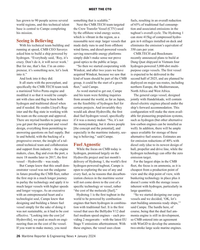 )
January 2024 - Maritime Reporter and Engineering News page: 26
)
January 2024 - Maritime Reporter and Engineering News page: 26MEET THE CTO has grown to 90 people across several something that is scalable.” fuels, resulting in an overall reduction world regions, and this technical talent Next the CMB.TECH team targeted of 65% of traditional fuel consump- base is central to Campe completing the Crew Transfer Vessel (CTV) used
-
 )
January 2024 - Maritime Reporter and Engineering News page: 20
)
January 2024 - Maritime Reporter and Engineering News page: 20TECH FEATURE Figure 4. The vessel’s cargo holds feature Figure 5. The walls of the cargo holds All images courtesy of The Interlake Steamship Company ? at bottoms that accommodate the use bene? t from a zinc-based coating that of heavy machinery, which necessitated provides durability in an area
-
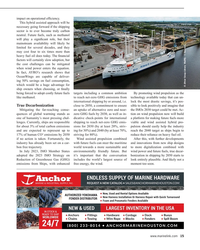 )
January 2024 - Maritime Reporter and Engineering News page: 15
)
January 2024 - Maritime Reporter and Engineering News page: 15impact on operational ef? ciency. This hybrid assisted approach will be necessary going forward if the shipping sector is to ever become truly carbon neutral. Future fuels, such as methanol will play a signi? cant role, but their mainstream availability will likely be limited for several decades
-
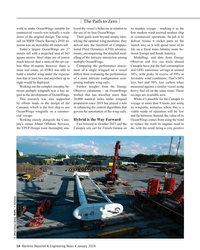 )
January 2024 - Maritime Reporter and Engineering News page: 14
)
January 2024 - Maritime Reporter and Engineering News page: 14The Path to Zero work to make OceanWings suitable for lyzed the vessel’s behavior in relation to its maiden voyage – marking it as the commercial vessels was actually a scale the use of its four OceanWings. ? rst modern wind assisted modern ship down of the original design. The wing- Their goals went
-
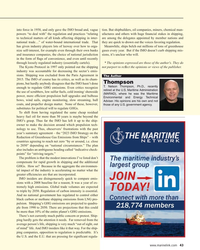 )
December 2023 - Maritime Reporter and Engineering News page: 43
)
December 2023 - Maritime Reporter and Engineering News page: 43into force in 1958, and only gave the IMO broad and, vague tion. But shipbuilders, oil companies, miners, chemical man- powers “to deal with” the regulation and practices “relating ufactures and others with huge ? nancial stakes in shipping, to technical matters of all kinds affecting shipping in inter-
-
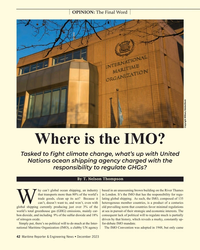 )
December 2023 - Maritime Reporter and Engineering News page: 42
)
December 2023 - Maritime Reporter and Engineering News page: 42OPINION: The Final Word Copyright William/AdobeStock Where is the IMO? Tasked to ? ght climate change, what’s up with United Nations ocean shipping agency charged with the responsibility to regulate GHGs? By T. Nelson Thompson hy can’t global ocean shipping, an industry based in an unassuming brown
